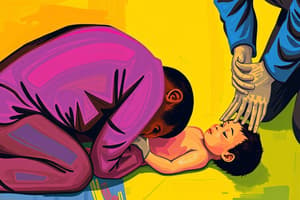Podcast
Questions and Answers
What steps do you follow to check the brachial artery pulse in an infant?
What steps do you follow to check the brachial artery pulse in an infant?
Place 2 or 3 fingers on the inside of the upper arm, between the elbow and shoulder, then press the fingers to attempt to feel the pulse for at least 5 to 10 seconds.
What steps do you follow to check the femoral artery pulse in a child?
What steps do you follow to check the femoral artery pulse in a child?
Place 2 or 3 fingers in the inner thigh, midway between the hip bone and the pubic bone, and feel for a pulse for 5 to 10 seconds.
What is the target rate for chest compressions for children?
What is the target rate for chest compressions for children?
100 to 120/min
During CPR on a child, you should place 1 or 2 hands over the __________ of the __________.
During CPR on a child, you should place 1 or 2 hands over the __________ of the __________.
During CPR on a child, interruptions to chest compressions should be limited to no more than _______ seconds.
During CPR on a child, interruptions to chest compressions should be limited to no more than _______ seconds.
What is the approximate depth of chest compressions for infants?
What is the approximate depth of chest compressions for infants?
When performing chest compressions for an infant, you can use 2 thumbs or put 2 ________ in the center of the chest, just below the ________ line.
When performing chest compressions for an infant, you can use 2 thumbs or put 2 ________ in the center of the chest, just below the ________ line.
When performing chest compressions for an infant in a 2-rescuer situation, you should put 2 _______ in the center of the chest.
When performing chest compressions for an infant in a 2-rescuer situation, you should put 2 _______ in the center of the chest.
What is the compression-to-ventilation ratio for infants and children when there is one rescuer?
What is the compression-to-ventilation ratio for infants and children when there is one rescuer?
What should you do if you witness a collapse and are alone?
What should you do if you witness a collapse and are alone?
If you are not alone during a witnessed collapse, what should you do?
If you are not alone during a witnessed collapse, what should you do?
What is the correct pad placement for AEDs on infants and children?
What is the correct pad placement for AEDs on infants and children?
What should you do if you are alone after an unwitnessed collapse?
What should you do if you are alone after an unwitnessed collapse?
What pads should you use for a child under 8 years of age?
What pads should you use for a child under 8 years of age?
If your AED includes smaller-sized pads for children, you should use them; if not, use the __________ pads while making sure that they don't touch or overlap.
If your AED includes smaller-sized pads for children, you should use them; if not, use the __________ pads while making sure that they don't touch or overlap.
Flashcards are hidden until you start studying
Study Notes
Pulse Checks for Infants and Children
- For infants, check the brachial artery pulse by placing 2-3 fingers on the inside of the upper arm, between the elbow and shoulder.
- For children, check the femoral pulse by placing 2-3 fingers in the inner thigh, midway between hip and pubic bones.
CPR Initiation
- If no pulse is felt within 10 seconds, or if the heart rate is 60/min or less, initiate high-quality CPR starting with chest compressions.
Chest Compressions: Children
- Compression rate: 100 to 120 compressions per minute.
- Compression depth: approximately 2 inches (5 cm).
- Hand placement: 1 or 2 hands on the lower half of the breastbone.
- Allow complete chest recoil; do not lean on the chest.
- Minimize interruptions to less than 10 seconds.
Chest Compressions: Infants
- Compression rate: 100 to 120 compressions per minute.
- Compression depth: approximately 1.5 inches (4 cm).
- Hand placement for one rescuer: 2 fingers center of the chest below the nipple line.
- For two rescuers, use the two-thumb-encircling hands technique.
- Complete chest recoil is necessary; interruptions should also be limited to less than 10 seconds.
Compression-to-Ventilation Ratio
- For one rescuer: 30 compressions to 2 ventilations.
- For two or more rescuers: 15 compressions to 2 ventilations.
Witnessed vs. Unwitnessed Collapse
- In witnessed collapse:
- If alone, leave to activate the emergency response system and get an AED before starting CPR.
- If not alone, send someone for the AED and begin CPR immediately.
- In unwitnessed collapse:
- If alone, start CPR with 30:2 cycles.
- After about 2 minutes, activate emergency response if still alone.
AED Use and Pad Placement
- Use child-sized pads for children under 8; otherwise, use adult pads ensuring they don’t overlap.
- For infants and children, place one AED pad on the chest and another on the back, following package instructions for proper orientation.
Pediatric BLS Algorithm for Healthcare Providers (Single Rescuer)
- Ensure scene safety before proceeding.
- Check for responsiveness by tapping the shoulders and shouting, “Are you OK?”
- If no response, shout for help and activate emergency response via mobile.
- Monitor breathing and pulse; if a pulse is felt without normal breathing, give rescue breaths every 2-3 seconds.
Studying That Suits You
Use AI to generate personalized quizzes and flashcards to suit your learning preferences.




